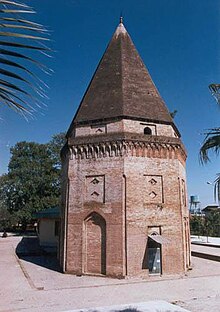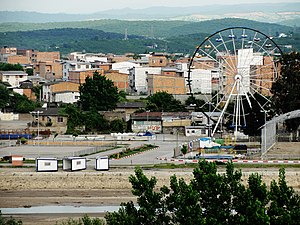Sari
| Sari | ||
|---|---|---|
|
|
||
| Basic data | ||
| Country: |
|
|
| Province : | Māzandarān | |
| Coordinates : | 36 ° 34 ′ N , 53 ° 4 ′ E | |
| Height : | 50 m | |
| Surface: | 50.89 km² | |
| Residents : | 297,517 (calculation 2012) | |
| Area code : | 011 | |
| Time zone : | UTC +3: 30 | |
| Website: | www.sari.ir | |
| politics | ||
| Mayor : | Mehdi Obouri | |
Sāri ( Masandaran and Persian ساری, also Shahr-i-Tajan ) is the capital of the Iranian province of Māzandarān .
geography
The city is located on the south coast of the Caspian Sea . It is located north of the Elburs Mountains . The population is just under 300,000 (2012 calculation), the city area is 5161 km². It is the most populous and the largest city in the province of Mazandaran. The name of the city is said to go back to Prince Sārūya, whose father, Ispahbadh Farruchān I the Great, ruled Tabaristan from Sāri in the early 8th century .
history

Excavations in the Hutto Cave indicate settlement of the area since the 7th century BC. After. According to legend, the city was from the Shahnameh -Helden Tus-i Naudhar (TUS, the son of Naudhar founded). The ancient Greeks knew the city as Zadrakarta . Zadrakarta was later destroyed by Alexander the Great . However, he had the city rebuilt under the new name Syrinx .
Later, at the time of the Sassanids and their vassal dynasty of the Dabuyids , from which Farruchān the Great came, the city became the capital of Tabaristan under the name of Sāri . From the 11th to the early 13th century, the second line of the Bawandid Ispahbadhs resided here .
After the invasion of the Mongols , Uzbeks , Turks and Turkmens , the city gradually lost its importance. Shah Abbas I incorporated Sāri into his kingdom and founded the city of Faraḥābād north of Sāri . Aga Mohammed Khan later declared Sāri to be his capital . However, the capital was later moved to Tehran . Under Reza Shah Pahlavi , the city was expanded and modernized. The Soviets occupied the city during World War II , but cleared it again after the war.
population
The city's population is mixed, in addition to the local Sāris, i.e. Mazandarans , Persians , Turks , Kurds , Pashtuns and refugees from Afghanistan (mixed ethnic groups) and Turkmen live here . Some Germans , Russians , Japanese and Arabs also live here. At the time of the Qajars , the individual districts were named after the ethnic groups living there or their areas of origin, such as Afghoun Mahalleh or Kurd Mahalleh . Most speak the Māzandarānī Saravi dialect. In addition to the above-mentioned ethnic groups, Georgians , Armenians and Zoroastrians also lived here.
After attacks like in April 711 by the general Tarik ibn Zeyad on the Spanish mainland, some Spanish peoples also settled there.
traffic
The city has a station on the Trans-Iranian Railway .
See also
Web links
Individual evidence
- ↑ Page no longer available , search in web archives:

